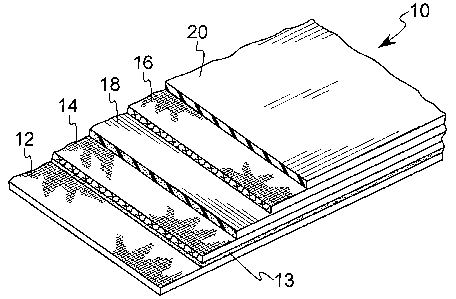Une partie des informations de ce site Web a été fournie par des sources externes. Le gouvernement du Canada n'assume aucune responsabilité concernant la précision, l'actualité ou la fiabilité des informations fournies par les sources externes. Les utilisateurs qui désirent employer cette information devraient consulter directement la source des informations. Le contenu fourni par les sources externes n'est pas assujetti aux exigences sur les langues officielles, la protection des renseignements personnels et l'accessibilité.
L'apparition de différences dans le texte et l'image des Revendications et de l'Abrégé dépend du moment auquel le document est publié. Les textes des Revendications et de l'Abrégé sont affichés :
| (12) Demande de brevet: | (11) CA 2626509 |
|---|---|
| (54) Titre français: | TOILE D'IMPRESSION PRESENTANT UNE STABILITE D'EPAISSEUR DYNAMIQUE AMELIOREE |
| (54) Titre anglais: | PRINTING BLANKET HAVING IMPROVED DYNAMIC THICKNESS STABILITY |
| Statut: | Réputée abandonnée et au-delà du délai pour le rétablissement - en attente de la réponse à l’avis de communication rejetée |
| (51) Classification internationale des brevets (CIB): |
|
|---|---|
| (72) Inventeurs : |
|
| (73) Titulaires : |
|
| (71) Demandeurs : |
|
| (74) Agent: | GOWLING WLG (CANADA) LLP |
| (74) Co-agent: | |
| (45) Délivré: | |
| (86) Date de dépôt PCT: | 2006-11-28 |
| (87) Mise à la disponibilité du public: | 2007-05-31 |
| Licence disponible: | S.O. |
| Cédé au domaine public: | S.O. |
| (25) Langue des documents déposés: | Anglais |
| Traité de coopération en matière de brevets (PCT): | Oui |
|---|---|
| (86) Numéro de la demande PCT: | PCT/US2006/045650 |
| (87) Numéro de publication internationale PCT: | WO 2007062271 |
| (85) Entrée nationale: | 2008-04-18 |
| (30) Données de priorité de la demande: | |||||||||
|---|---|---|---|---|---|---|---|---|---|
|
Toile d'impression résistant à la perte d'épaisseur pendant toute sa durée de vie utile lorsqu'elle est soumise aux pressions de pincement de ligne d'impression. La toile d'impression comprend une couche superficielle d'impression et au moins une couche de tissu. La couche de tissu est traitée par imprégnation avec un composé d'uréthane élastomérique à 100 % de solides qui pénètre dans les espaces d'air des faisceaux individuels de fibres dans la couche de tissu et bloque le mouvement relatif des fibres individuelles dans la couche de telle sorte que la toile soit résistante à une déformation permanente. La toile comprenant la couche de tissu traitée conserve au moins 95% de son épaisseur d'origine pendant toute sa durée de vie utile.
A printing blanket is provided which resists gauge loss throughout its useful
life when subjected to printing nip pressures. The printing blanket includes a
printing surface layer and at least one fabric ply. The fabric ply is treated
by impregnation with a 100 % solids elastomeric urethane compound which
penetrates the air spaces of individual fiber bundles in the fabric ply and
fixes the individual fibers in the ply from relative movement so that that the
blanket is resistant to permanent deformation. The blanket including the
treated fabric ply retains at least 95% of its original gauge throughout its
useful life.
Note : Les revendications sont présentées dans la langue officielle dans laquelle elles ont été soumises.
Note : Les descriptions sont présentées dans la langue officielle dans laquelle elles ont été soumises.

2024-08-01 : Dans le cadre de la transition vers les Brevets de nouvelle génération (BNG), la base de données sur les brevets canadiens (BDBC) contient désormais un Historique d'événement plus détaillé, qui reproduit le Journal des événements de notre nouvelle solution interne.
Veuillez noter que les événements débutant par « Inactive : » se réfèrent à des événements qui ne sont plus utilisés dans notre nouvelle solution interne.
Pour une meilleure compréhension de l'état de la demande ou brevet qui figure sur cette page, la rubrique Mise en garde , et les descriptions de Brevet , Historique d'événement , Taxes périodiques et Historique des paiements devraient être consultées.
| Description | Date |
|---|---|
| Demande non rétablie avant l'échéance | 2011-11-28 |
| Le délai pour l'annulation est expiré | 2011-11-28 |
| Réputée abandonnée - omission de répondre à un avis sur les taxes pour le maintien en état | 2010-11-29 |
| Inactive : Notice - Entrée phase nat. - Pas de RE | 2009-03-13 |
| Demande de correction du demandeur reçue | 2008-08-20 |
| Inactive : Page couverture publiée | 2008-07-28 |
| Inactive : Notice - Entrée phase nat. - Pas de RE | 2008-07-23 |
| Inactive : CIB en 1re position | 2008-05-08 |
| Demande reçue - PCT | 2008-05-07 |
| Exigences pour l'entrée dans la phase nationale - jugée conforme | 2008-04-18 |
| Demande publiée (accessible au public) | 2007-05-31 |
| Date d'abandonnement | Raison | Date de rétablissement |
|---|---|---|
| 2010-11-29 |
Le dernier paiement a été reçu le 2009-11-06
Avis : Si le paiement en totalité n'a pas été reçu au plus tard à la date indiquée, une taxe supplémentaire peut être imposée, soit une des taxes suivantes :
Veuillez vous référer à la page web des taxes sur les brevets de l'OPIC pour voir tous les montants actuels des taxes.
| Type de taxes | Anniversaire | Échéance | Date payée |
|---|---|---|---|
| Taxe nationale de base - générale | 2008-04-18 | ||
| TM (demande, 2e anniv.) - générale | 02 | 2008-11-28 | 2008-10-31 |
| TM (demande, 3e anniv.) - générale | 03 | 2009-11-30 | 2009-11-06 |
Les titulaires actuels et antérieures au dossier sont affichés en ordre alphabétique.
| Titulaires actuels au dossier |
|---|
| DAY INTERNATIONAL, INC. |
| Titulaires antérieures au dossier |
|---|
| JOSEPH L. BYERS |
| SAMUEL R. SHUMAN |
| W. TORIRAN FLINT |